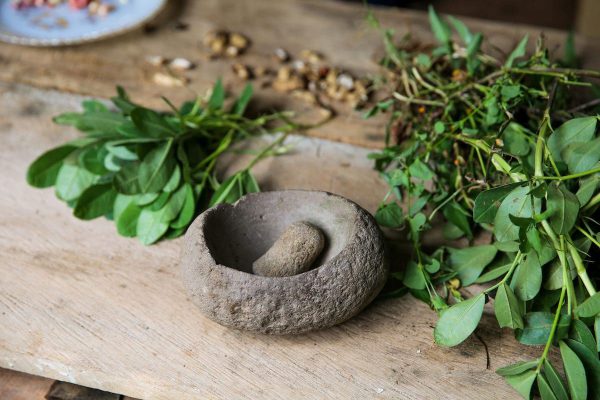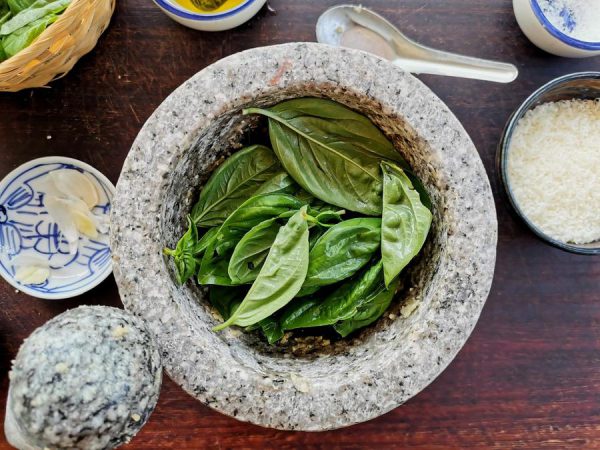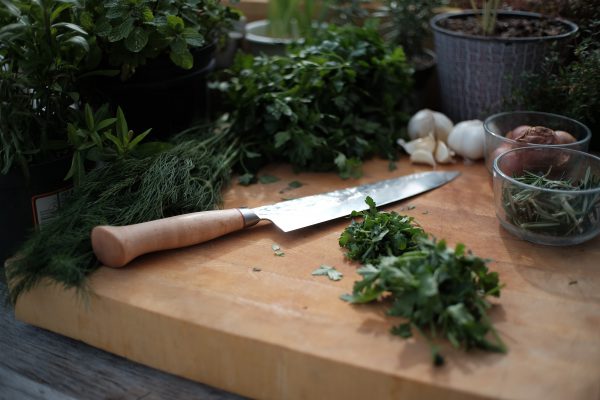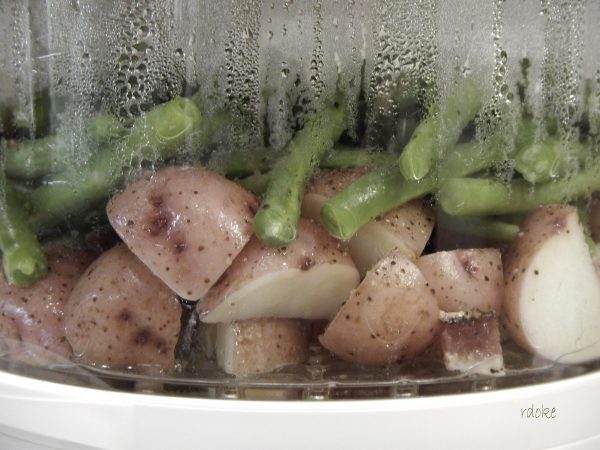Last Updated on March 10, 2023
All the cultures on earth have their own take on mortar and pestle, made of materials found in their backyards, like the Mexican molcajete, Thai granite mortar, or Italian marble mortar. Their purpose is simple: to crush, smash, grind, and pulverize, making it easy to prepare various ingredients for cooking, medicinal practices, painting, or even magic if that’s what you’re into.
As per their function, mortar and pestles usually come in quite crude designs. But a set of Japanese suribachi and surikogi is different from other mortar and pestle sets. When you hold one such set in your hands, the first thing that strikes you is the delicacy of both the bowl and the club.
When it was first introduced into the cuisine, the set transformed how Japanese cooks handled ingredients, thanks to its subtle yet clever design. What’s so special about this set? Let’s delve deep into suribachi and surikogi.
What Are Suribachi and Surikogi?
By anajay74
Most of the mortars around the world are quite sturdy tools made of solid materials like granite, marble, volcanic rock, or wood, but not suribachi and surikogi. A suribachi is not only more delicate, thanks to its elegant subtleties, but it’s also a much more advanced tool than its primitive cousins.
Suribachi

Suribachi stands for the bowl of the set. It’s made of terracotta and glazed only on the outside. Unlike regular glazed terracotta mortars, such as the Thai glazed terracotta mortar, suribachi is not a smooth bowl.
The finely crafted earthenware has rough ridges on the inside and slightly thicker rims. These ridges, called kushi-no-me, are made by shaping the clay with a comb-like tool when still soft. The result is a groove pattern consisting of parallel and crisscrossing lines. Like most Japanese artisan crafts, a suribachi is very pleasing to look at — and would make a great centerpiece as a countertop decor.
What the ridges do is significantly increase the surface you grind in. A suribachi is a delicate tool that you should never bash with brute force. But these ridges increase the friction so successfully that you can elegantly grind ingredients only by swirling the wooden club in the bowl. The thicker rims help keep the ingredients inside the bowl, which is a great feature when grinding grainy stuff like sesame seeds.
Surikogi
By Umbradox
Surikogi is the wooden pestle counterpart of the set. At the end of the day, a suribachi is a ceramic bowl, so it wouldn’t make sense to use a hard natural rock pestle on it. Although it’s not uncommon to use a ceramic pestle with ceramic mortars around the world, a rougher material could easily smooth out the much-needed ridges in suribachi. That’s why in Japan, a surikogi is strictly made of wood.
The very traditional surikogis are made of the Japanese pepper tree, sansho bush, the bark of which is thought to have detoxification properties and is historically believed to prevent food poisoning. Whether or not it has an effect on the toxins, the peppermint bark does add a subtle aroma to the ingredients, working like a natural solution to the seasoning process that some other mortars require.
Suribachi and Sukirogi in Japanese Cuisine
By 田中 駿二
The mortars and their pestles are always optimized for the ingredients traditionally used in the local cuisine. The suribachi and surikogi are no different, which is why they efficiently grind sesame seeds, help make miso pastes, or grind down meat to make tender tsukune dumplings.
The set was so revolutionary, it almost completely altered Japanese cuisine when it was introduced to the country. Take sesame seeds, for example. They are both delicate and likely to jump across the room, even with a gentle nudge. If you don’t have the optimal tool, you can’t possibly grind them without sloshing them and making a mess in the meantime.
The Edo period, when Japan’s food culture is said to have flourished, is also when the suribachi found its final form. During that time, new dishes were created one after another that made use of natural ingredients in different ways. The cooks started incorporating ground spices more often, creating pastes from vegetables and seeds, and introducing revolutionary recipes to the local cuisine overall.
For example, before the widespread use of mortar and pestle, miso was prominently eaten as a side dish. With suribachi and surikogi, it became easier to dissolve it into a soup, giving birth to one of the most popular Japanese dishes: the miso soup. Wasabi, ginger pastes, and many other condiments also appear during this time.
Today, a suribachi and a surikogi is a piece of indispensable equipment to grind sesame seeds, make miso soup, shiraae dishes, tender tsukune dumplings, and more. But the set also excels at making dishes from other cuisines, such as muhammara from the Middle East, garam masala from India, or harissa from northwestern Africa.
Suribachi and Surikogi vs. Natural Rock Mortar and Pestles
Natural rock mortar and pestles are literally stone-age technology, so they’re hard to mishandle. A hard rock mortar and pestle has several advantages. First of all, it’s literally hard as a rock and very heavy. The Thai granite mortar and pestle set is the sturdiest and heaviest one among them. Marble is the second hardest raw material shaped into mortar and pestles, followed by the Mexican molcajete, made of volcanic rock.
A granite mortar and pestle lets you pulverize with your full power. The heavy pestle also adds to the force you apply. This means you can grind hard spices in it, like peppermint, or make a smooth paste faster than you would with any other mortar and pestle set.
However, the hard stones also easily bruise delicate ingredients. If you’re looking to make some fruit salsa with chewy pieces in it, a molcajete is the best option.
On the other hand, suribachi and surikogi excel at softly grinding delicate seeds. Plus, thanks to the grooves in the suribachi, you can froth up a cream much faster compared to other mortar and pestles.
The different types of mortar and pestle sets all have their strong suits. If you’re thinking about adding one to your kitchen arsenal, it’s important to pick one according to your needs. For a more comprehensive guide, check out our guide to choosing the best mortar and pestle.
How to Use Suribachi and Surikogi
By Elena Chesta
There are sets of mortar and pestles all over the world, but suribachi stands out with its almost therapeutic trench patterns that help the holder grind delicate ingredients gracefully. Paired with a lightweight wooden club, the set easily pulverizes delicate ingredients.
The cleverly designed bowl might be one of the most fragile kitchen equipment you’ll ever hold. This means you need to be delicate when using one. If you’re used to bashing with your full power, consider this your introduction to Zen Buddhism. If you try to use brute force with this mortar, you’ll most likely chip the unglazed grooves or worse crack the bowl.
To use the suribachi and surikogi set efficiently and elegantly, hold the middle of the pestle with your dominant hand and place your other hand on top. Grind the ingredient, such as sesame seeds, by turning the pestle using your wrist, on the axis of your top hand. Use the weight of the pestle to grind without applying too much force. The point is to keep the hand on top and turn the hand you hold in the middle! The principle of leverage allows you to do it effortlessly.
Before You Go Grind Something Delicious
A mortar and pestle might be the best thing to happen to a stone age cook. As ancient as these culinary tools are, we’re still using them insistently, as no other tool has yet beat (pun intended) the aromatic pastes you can prepare with a good set of mortar and pestle.
Suribachi and surikogi, the Japanese mortar and pestle set, is subtly and cleverly designed so that you can gently pulverize the ingredients commonly used in East Asian cuisine and more.
If you want to incorporate these ingredients in your dishes and get more intimate with East Asian ways of cooking, a set of suribachi and a surikogi is a valuable addition to your kitchen.












